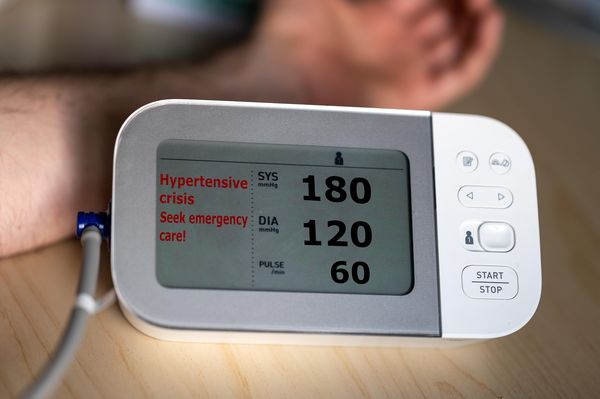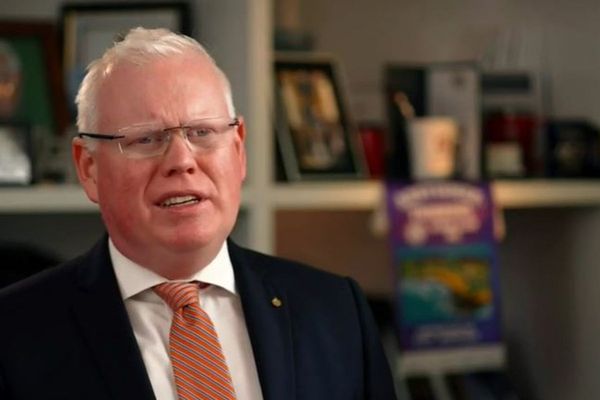
“Which one does not belong?” Erin Cleary asks her fifth graders, pointing to four prisms on a screen at the front of her classroom on the South Side.
To find the answer, “think time” begins.
“Turn and talk to your partners,” Cleary tells her students, each outfitted in a maroon polo shirt on a recent morning. “Come up with which one you think does not belong — and why. And then be prepared to answer out loud.”
Chatter spreads across the second-floor classroom at Earle STEM Academy. Many ideas are offered. Some students eyeball each prism, trying to decide which shape looks different. Others try to figure out the volume by multiplying the sides.
Cleary walks around, listening and responding with a skeptical “hmmm.”
Cleary’s students, like many across Chicago and the nation, are struggling with math in the wake of the pandemic and remote learning.
Overall, only 17.5% of Chicago Public Schools elementary students met or exceeded math standards on the 2023 state test, according to scores released Tuesday. That is slightly better than 14.9% in 2022, but still less than 23.6% in 2019, before the pandemic.
And students from low-income families, like those at Earle, remain far behind middle-class and affluent students in math. The gap between these two groups is 32 percentage points.
Perhaps most alarming, 35.1% of low-income students scored in the lowest category, meaning they were not even “partially meeting” or “approaching” state math standards. That’s up from 25.4% in 2018.
Language arts scores also suffered during the pandemic, but students have bounced back this year much more than in math. English language arts test scores remain low, but students are almost back to where they were pre-pandemic, with 25.9% meeting standards.
Speaking at Earle in West Englewood earlier this month, Pedro Martinez, the CPS chief executive officer, noted some progress in math but said it is “not fast enough.”
“It is a call to action,” Martinez said. “But what I love is that we are figuring it out.”
Martinez and other CPS officials point to Earle as a model for how they will attempt to improve math instruction and performance in the coming year — and try to recover what was lost during the pandemic.
State test scores show only 2.8% of Earle students met standards in math this year, and half the students scored in the lowest category — which means they neither partially met nor approached state standards.
The school has adopted CPS’s preferred math curriculum, called Skyline, and the staff is trying to get kids engaged and feeling positive about math. Earle also has an interventionist teacher who moves among classrooms, focusing on math. AmeriCorps tutors are in classrooms. And there’s a new lab full of 3D printers, sewing machines and other equipment so students can do projects that will make math come alive.
Ten-year-old London Coleman said having Martinez visit her class and devote resources to her school makes her feel proud.
“We are building up to wonderful greatness,” she said.
Though in recent years the district has downplayed test scores, London still knows her score in reading and that it was far better than in math. “I try my super best in math,” she said. “But sometimes I just need a little bit of help. But once it clicks, my mind is good.”
When CPS returned from remote learning in 2021, schools tended to focus on literacy and the social emotional well-being of students, according to Bogdana Chkoumbova, the school system’s chief education officer. Math did not get the same attention, even though many students had missed some foundational lessons, making it hard to catch up in a subject where skills build upon each other.
“Math is a gatekeeper: Either students pass through the gate,or it keeps students back,” said Sarah Powell, an associate professor of special education at The University of Texas at Austin, who is part of a group pushing schools to do more explicit math instruction. “So, when students struggle with counting, that makes addition, subtraction, multiplication and division harder.”
Chkoumbova said standardized test scores tell only part of the story but called low math scores alarming and said they indicate something significant needs to change.
This school year, Chkoumbova wants educaors to think about whether they need to devote more instructional time to math and to incorporate it across subject areas. Some schools spend two or three times as much time on reading as on math.
“Forty, fifty minutes of math instruction perhaps is not sufficient,” she said.
Pouring in resources
After about two minutes of chatter, Cleary calls her fifth-grade class back to attention. She asks several students which prism they think does not belong. One says prism B because its volume is different from the other three. He’s attempting some higher-level math but struggles with a building block skill — he stumbles as he tries to multiply four times six.
“We have to work on the math,” Cleary tells the boy in her kindest teacher voice, “but that’s OK.”
Students come up with the answer only after Cleary tells them to pay attention to the labels. Three of the prisms have labels expressed in inches. One is in centimeters.
“Oh,” the kids exclaim as they realize they were making the question much harder than it needed to be. The lesson was less about math fundamentals and more about how to think about a problem.
Cleary is using a curriculum vetted by district officials as part of Skyline, a CPS initiative to provide high-quality lesson plans in every grade and subject. Before launching Skyline in 2021 CPS had no universal curriculum, leaving curriculum design and planning up to each school and teacher. Schools are being strongly encouraged to use Skyline, but it’s not required.
Chkoumbova said she thinks math scores have not improved as much as CPS officials wants because fewer schools are using Skyline for math than for other subjects.
Fewer than 100 schools were using Skyline’s math curriculum in October 2022, according to CPS data, though officials said adoption has picked up since then.
Earle adopted it across the board in the middle of last school year. Cleary said she likes the Skyline curriculum because it is intentional and one lesson builds on the next.
Skyline is digital. In Cleary’s class, all students have a laptop on their desks. But the curriculum also calls for lots of student discussion, explanations and the use of manipulatives, such as blocks or sets of cubes.
Earle hired a math consultant to come in and work with the teachers, according to Regina Latimer-Lake, the school principal.
On the day Martinez and other CPS visited Earle, a first-grade class was also doing a Skyline lesson. The students were learning about predictions and counting by 10. They sat on a rug in front of their teacher, much as they would do if they were getting a story read to them.
First, the teacher shook a basket full of cubes and asked them to guess the total number of cubes. Then, they counted by 10 as she removed the sets of 10 cubes. As they answered the questions, the kids squirmed and talked to each other.
“They are excited, and they are learning concepts without realizing they are learning,” Martinez said. “If you don’t make it visual for children, it is very difficult for them to learn it.”
The school also just got a “makers lab,” with 3D printers, sewing machines and other materials designed to help math and science come alive for the students. On the day Martinez visited, students were making models of red blood cells. Part of the task was scaling the red blood cells, which one student explained are “very, very small” in real life.
Martinez and Chkoumbova said Earle is taking advantage of many of the supports CPS put in place to help recover post-pandemic. Each school received money to hire an interventionist to work with struggling students. At Earle, unlike many schools, the interventionist is working on both math and reading. The school also has small class sizes and tutors from AmeriCrps, which pays young adults stipends to volunteer.
Having interventionists and tutors means students lacking basic skills can get pulled out and supported. It also means fewer will slip through the cracks because someone might notice that they are lost.
Striking a balance with math instruction
Every day, Cleary starts class by asking students to say something positive about math so they can “persevere when it gets hard.” Some students say they feel as if math makes them smarter. Another says there are times math can help in their everyday lives.
Corey Morrison, CPS’s director of math, said “math identity” is important. If kids say they hate math, they won’t do well in it. But if they love the challenge of math and think they are good at it, they will do better, he said.
Focusing on math identity is one way Morrison is trying to shift math instruction in CPS. Morrison also is trying to help teachers navigate instructions from CPS leaders to accelerate learning post-pandemic, rather than remediate. This meant giving students who returned from the pandemic in third-grade lessons that are designed for third-graders, even if they missed or were not strong in some second grade skills.
Before the pandemic, educators weren’t as aware of how quickly students can fall behind in math, he said. But he said it’s possible to accelerate learning. The key is teaching students how to attack and think through a problem, he said.
“It’s not about just getting the answer, and it’s not about understanding just this algorithm or this procedure because that’s not what math is really about,” he said. “Math is really about problem-solving.”
Morrison and CPS teachers also find themselves having to strike a balance between teaching higher-order thinking skills and making sure students have a firm foundation. For more than a decade, math education has been moving away from rote memorization of procedures and math facts, such as multiplication tables. Instead, the focus has been on inquiry-based math and learning how to problem-solve.
Yet many are now calling for a return of explicit math instruction. Powell said learning math is all about practice, something many kids did not do much of during the pandemic. She said now students need to get foundational skills, or they will be left behind. Students need direct explanations of procedures and formulas, as well as concepts.
Leaders of the National Council of Teachers of Mathematics worry, though, about this push toward teaching the basics. It opposes rote memorization, saying students are turned off math when it is taught as a boring set of procedures.
Morrison said both are important. Students will get stuck if they don’t know math facts and procedures. But they also need to know how to wrestle with a problem, he said.
At Earle, Martinez said he wants to replicate the math education and support he sees there.
“If we can do it in Englewood, we can do it in any neighborhood,” he said.
Sarah Karp covers education for WBEZ.







